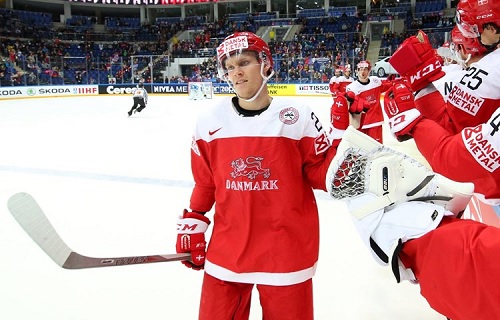Denmark Knocks-off Kazakhstan at the 2016 World Championships

Denmark moved to within touching distance of a quarter-final spot after wrapping up its Group A campaign with a comfortable win over Kazakhstan.
Tonight’s 4-1 victory means that only a regulation win for Switzerland over the Czech Republic in the early game on Tuesday could deny the Danes an appearance in the last eight for only the second time ever.
Three unanswered goals in the first period set Denmark on its way to a triumph driven by an impressive power play that delivered all four goals over the course of the night.
Markus Lauridsen got things rolling in the ninth minute with a slap shot off Lars Eller’s feed that whistled past Pavel Poluektov. Then two goals in 64 seconds put the game almost out of Kazakhstan’s reach inside 18 minutes. First Yannick Hansen cut in from the left-hand boards and shot from inside the circle, beating Poluektov through his pads.
Moments later Nicklas Jensen, Denmark’s leading scorer in Moscow, got his fifth goal of the campaign as Frederik Storm picked up his second assist of the night. After a scrummage on the boards sucked in most of the skaters, Jensen held his position in the centre and reaped the benefits when the puck broke for him in plenty of space to conjure up a vicious wrister that fizzed over the pad and inside the near post.
There was little sign of any nerves from the Danes who, in the words of Eller, did “a good job of making them look bad”.
“We got on them right away,” he said. “We didn’t give them anything and we scored on our chances.”
Kazakhstan swapped goalies for the second period, bringing in Dmitri Malgin for his first ever minutes in World Championship hockey at any level. He got an instant greeting from Eller, who dinged a shot against the piping in the first minute of the stanza but soon saw his team reduce the arrears.
Brandon Bochenski, alert as the teams changed on the fly, picked out Nigel Dawes with a superb pass from blue line to blue line and Kazakhstan’s leading scorer went on to win his duel with Sebastian Dahm in the Danish net.
But any prospect of a fightback was snuffed out by the next Kazakhstan penalty and yet another power play goal. Nikolaj Ehlers was the scorer, beating Malgin from the top of the circle.
Ehlers, enjoying his first World Championship, was happy with his team’s performance.
“We played with our hearts,” he said. “We played for Denmark. It showed yesterday and it showed again today. We knew we had a good chance to win and we were excited to be in this game.”
With the outcome of the game clear, the third period offered less of a spectacle. Kazakhstan got a boost when it finally killed a penalty early on. Denmark, no longer needing to up the tempo, made little impression in 5-on-5 play and the action drifted to a tame conclusion. Now Denmark must hope that the Czechs can at least take the Swiss to overtime and help the Scandinavian country reach the last eight for the first time since 2010.
For Kazakhstan, though, the future holds a return to Division 1A after a campaign that began so brightly fizzled out.
Team captain Maxim Semyonov complained that indiscipline on the ice had left his team with too much work to do.
“Even though we had nothing to play for on the night we tried hard again,” he said. “All of their goals came when we were shorthanded but throughout the tournament we have taken too many penalties.
“Right now, that is the problem with team Kazakhstan – too many silly penalties that cost us too many goals.”
But for the Danes, it’s been a far more satisfactory championship.
“We’ve taken our team to a new level, regardless of what happens tomorrow,” Eller said. “I think it’s the first time we’ve had four wins, and we were right there against Switzerland. We’ve had a great tournament.”

